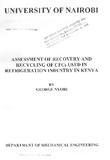| dc.description.abstract | Ozone depletion and its after effects on the life on earth have become a matter of global concern. In 1987, at Montreal in Canada, the international community came together for taking the necessary steps to stop further damage to the stratospheric ozone layer. The man-made Chlorofluorocarbons (CFCs) were among the Ozone Depleting Substances (ODS) that were to be controlled. In the Montreal Protocol (1987) the world adopted a programme of heavy cuts in the use of CFCs. It was agreed that production (not consumption) of CFCs is to be finally phased out by the year 2000. Several meetings have been held since Montreal 1987) which have adjusted the ODS phase-out program initially proposed
CFCs consist of Chlorine, Fluorine and Carbon and are mainly used, in Kenya, in the refrigeration industry. CFC-12, CFC-500, CFC-502 are the CFCs used as refrigerants in Kenya. Kenya’s developing economy is very much depended, mainly, on the use of these CFCs. It is therefore crucial to keep major services running while preventing Kenya from becoming a dumping ground for obsolete equipment. With 10 years grace period for developing countries like Kenya, the sustenance of the existing CFC-based equipment will depend on the success of conservation programmes such as recovery and recycling, waste reduction measures and retrofit technologies.
This report therefore presents the background analysis that is intended to facilitate the launching of efficient programmes for collection, recovery and recycling, waste reduction measures and retrofit technologies. The report also presents the background analysis appropriate for legislation and institutional strengthening for the purpose of implementation of the programmes.
A comprehensive field survey auditing the usage of refrigerants in Kenya was carried out in the major towns such as Nairobi, Mombasa, Kisumu, Nakuru, Eldoret etc. The audit was used to develop a national guideline on the current level of usage of refrigerants in Kenya. The audit involved interviews through questionnaires and checklists covering extensively both primary and secondary sources of information. In the data collection exercise, 910 questionnaires were distributed to various groups. 563 of the questionnaires were received back and among them 448 had useful information. The audit exercise was therefore based on these 448 questionnaires.
The findings of the audit indicated that in 1995 the consumption(the amount used excluding the ‘banked’ quantity) of refrigerants were 67.7MT of CFC-12, 29.6MT of HCFC-22, 0.4MT of Ammonia, Negligible amounts of HFC-134a, CFC-502, Hydrocarbons and of liquid CO2 . The amounts ‘banked’ within the refrigeration equipment were 103.1MT of CFC-12, 41 2MT of
HCFC-22, 1MT of Ammonia and negligible amounts of HFC-134a, CFC-502, Hydrocarbons and of liquid C02. Kenya does not manufacture any of the above chemicals, except liquid CO2 , and therefore all are imported. There exists a lot of undocumented information pertaining to the importation of these refrigerants and appropriate legislation and institutional strengthening is needed for the success of conservation programmes.
Montreal Protocol awareness by direct and indirect users was evaluated through checklists and questionnaires. It was established that most Kenyans are ‘cost’ conscious and not environmental conscious. Therefore the incentive to awareness is purely motivated by business consideration and not by environmental issues.
v
Most servicing practises are unorthodox and these have led to a lot of refrigerant waste, of the order 41.5MT (61.3%) of CFC-12 in 1995 due to flooding within the market by many unqualified and unregistered servicing technicians and agents. Refrigeration equipment and refrigerant technologies in current end users were also studied to determine the level of technology in the country. The present legislative and institutional framework with respect to CFCs is limited and therefore the country lacks an established machinery to ensure elaborate enforcement of regulations and legislation on the use of refrigerants.
With the current level of consumption the maximum attainable CFC-12 through recovery and recycling is in the order of 21 4MT in 1995. This amounts to 49.3% of recharging demand or about 31.6% of the total demand for CFCs. Viable recoveiy and recycling programmes can be set up at a profit given initial financial support. This will set refrigerant ‘banks’ and thus avoid premature scrapping or costly retrofit of CFC-12 equipment upto the year 2010 which is the terminal year for CFC-12 usage for developing countries.
The findings of the analysis indicate that given adequate support and with appropriate legislation and institutional strengthening for implementation , viable programmes for recovery and recycling of refrigerant gases can be set up in Kenya. The analysis showed that recovery and recycling in Kenya will be economically viable at the venture level. However financial incentive by the Government of Kenya and the international community will be required to promote the implementation. In the context of the findings of the analysis, it is desirable and necessary to introduce regulatory legislative measure regarding various aspects of CFC consumption such as sales, purchasing and conservation through recovery and recycling.
In order to initiate and implement the above scheme, it is necessary to strengthen the institutional framework in Kenya. This would involve creating proper awareness about the harmful effects of ozone layer depletion and the repercussions of the Montreal Protocol to Kenyan Refrigeration Industry. The existing legislation related to licensing, control and standards for importation, local manufacture and use of chemicals and equipment is considered inadequate for implementation of the refrigerant conservation programmes. It is recommended that:
• The licensing of refrigeration contractors and service agents be restricted to trained and registered technicians.
• The retailing of CFCs be restricted to registered suppliers and contractors and service agents only.
Apart from the above legislative acts proposed herein, the Government of Kenya has already established the National Environmental Secretariat (NES) whose duties are spelt out in the Institutional Framework. The various personnel, material policies and modalities for the implementation of conservation programme and long term regulation of use of CFCs already exist and only needs to be put into practice. | en_US |



